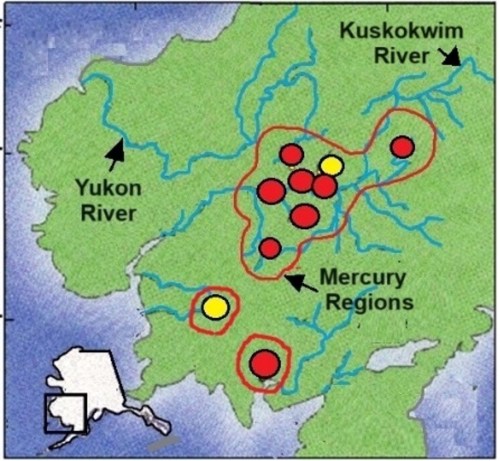
A research study by USC Dornsife College of Letters, Arts, and Sciences concluded that the concentration and volume of mercury present in Alaska’s Yukon River Basin is unusually high (see here).
The researchers contend that these high values were caused by the rapid melting of icy permafrost accumulations present along the Yukon River that are rich in mercury. They are certain that the rapid melting was caused by the dramatic increase in atmospheric temperature related to climate change.
The study’s scientists say that as our planet continues to rapidly and unnaturally warm due to climate change, it will melt massive accumulations of icy permafrost and other types of ice that are rich in mercury present in the Arctic.
Eventually, the continued release of large amounts of mercury into the Arctic could irreversibly damage or destroy the Arctic’s biological and physical environments. They have nicknamed this impending disaster the “Mercury Bomb”.
This study has ignited heated discussions concerning what steps we should take to avert this impending environmental disaster. Here we provide evidence showing the “Mercury Bomb” Theory didn’t include all the relevant data, observations, and information, raising doubts about the foundational principles of the theory.
1. The study was performed in the Alaska part of the Yukon River. This river flows west across Alaska and empties into the Bering Sea. The problem is that the Bering Sea is the northern extent of the Pacific Ocean and not part of the Arctic Ocean. Stating that the Yukon River’s mercury affects the entire Arctic is misleading.
2. The Yukon River and its encompassing basin is approximately 2,900 miles long, 2 miles wide, and has an area of 5,800 cubic miles which makes it the third largest river in the United States just behind the Missouri and Mississippi Rivers. The study samples were collected at two small areas along the river, which were then used to determine the entire river’s mercury concentration. It is impossible to have confidence that two samples taken across this huge river basin could reflect the average or variations in mercury concentration.
3. The Arctic’s atmospheric temperature has been characterized as extremely high due to climate change. Data shows that this is not true for Alaska. Alaska’s atmospheric temperature was far cooler than the atmosphere above the Arctic Ocean from October 2021 to September 2022 (Figure 2 and here). Its atmospheric temperature was below freezing in 2012, 1971, and 1975. Concluding that climate change is the only force that is presently and has historically melted abnormal amounts of glacial and river ice does not coincide with the data.

4. The Alaska part of the Yukon River lies atop a large area of unusually hot bedrock/rock layers (see here). The heat flow from these bedrocks is melting the river’s permafrost—not climate change.
5. There are approximately twenty mercury mines located in the Yukon River and Kuskokwim River Basins region (Figure 3). Mercury mining in this region began in 1884, so it is difficult to know the exact number or distribution of mines. However, one thing is certain. The mine’s waste rock and sand were dumped into areas adjacent to the Yukon and Kuskokwim. Periods of flooding on most rivers can occur many times a month or in a year.
The same is true for the Yukon River and Kuskokwim River Basin regions. These floods alter the amount of mercy present in previously sampled locations making it near impossible to have confidence that the new samples can be used to establish reliable trends of mercury concentrations or volumes.
There is another problem. Rivers that are of high volume and flow rate are prone to continuously altering the location of sands laterally and downstream.

Figure 3 outlines in red the region that has very high concentrations of mercury in Alaska. However, within this region, there are small areas that have extremely high concentrations of mercury. These areas coincide with the position of the mercury mines.
It makes sense that the miners would choose small areas with extremely high mercury concentrations. As is true of many all-metal mines, the extremely high concentration areas were created by geological features such as faults, ancient rock layers, ancient upflows of lava, and volcanic eruptions.
6. Large amounts of mercury emitted from land and ocean geological features into the Arctic have been greatly underestimated and not included in models that assess the environmental problems currently attributed to anthropogenic actions. Here are a few examples of these geological features and their location in the Arctic.
7. Greenland concentration of natural mercury. “Unlike polluted rivers in other parts of the world, contaminated by industrial activity, the researchers believe the Greenland mercury is coming from natural sources. If it were coming from human pollution, then the snow on top of the ice sheet should also be full of mercury—yet previous studies have shown it’s comparatively clean. Instead, the scientists believe the meltwater mercury is probably leaching out of the bedrock beneath the ice. “Mercury concentration in the meltwater rivers was at least an order of magnitude higher than the concentrations found in ordinary rivers across the Arctic. These concentrations became slightly diluted by the time they flowed out into the fjords—but were still higher than expected, the researchers say. “Even after mingling with the salty water, the levels in the fjords remained about an order of magnitude higher than the mercury levels found in most open ocean waters”. (see here and here).
Greenland’s Kvananefjid Mine (see here) is located along the pristine coast of southwest Greenland (Figure 4 and see here). Rocks in this area are proven to be rich in mercury, radioactive uranium, and phosphate. This mine area was close to opening because it had one of the largest accumulations of radioactive uranium in the world. Indigenous native tribes in the area protested and the opening of the mine was not allowed. The news is that the mine will soon open.
Having worked in an open pit/land surface mine as a geologist for two summers, I learned that open pit mining, which the new owners will do, is an extremely messy business. So, the mercury and the phosphorus in the mined rocks and in the reservoir built to hold mine waste will likely leak into the oceans and bays especially when mining operations end.
Currently, mine operators are no longer responsible for maintaining waste reservoirs or other parts of the mine area. This greatly increases the chance that the waste reservoirs or other parts of the mine area will fail and no longer keep mercury from flowing into rivers and oceans. As evidence, you may recall the failure of a phosphate mine in Florida (see here).

8. The eruption of Iceland’s Fagradalsfjall volcano (Figure 1) emitted molten lava and gases both of which contain mercury (see here). The volume of mercury expulsed into the atmosphere and oceans by large, medium, or small size land or ocean volcanic eruptions is based on the monitoring of very few volcanoes. Therefore the accuracy of calculating how much mercury is emitted from volcanic eruptions versus human sources is guesswork.
Remember that we have only mapped 25 percent of our ocean floors with high-resolution devices that can see minor low-relief geological features. Several research studies have proven that high-resolution mapping has allowed them to see 30-40 percent more small geological features.
9. The Arctic Ocean floor is home to hydrothermal vents, volcanoes, and the vast, 3,000-mile-long Mid-Arctic Rift System—an active, shifting continental rift. The fault system is currently very active, which has already and will in the future generate thousands of medium and small-size faults (Figure 5). When adding up all of these ocean floor geological features there are at least 50,000 geological features, many of which are the Arctic Ocean and land.

Summary
A research study by USC Dornsife College of Letters, Arts, and Sciences concluded that the concentration and volume of mercury present in Alaska’s Yukon River Basin is high.
They believe that these high mercury values are the result of increased atmospheric temperature caused by climate change, which has acted to melt large areas of icy permafrost that contain substantial amounts of mercury.
Large amounts of relevant data, observations, and information were not included in their analysis. When included it invalidates the “Mercury Bomb” theory.
Biography
James Edward Kamis is a retired geologist with 47 years of experience, a Bachelor of Science degree in Geology from Northern Illinois University (1973), and a Master of Science degree in Geology from Idaho State University (1976). Nearly five decades of research have convinced him that geological forces significantly influence, or in some cases completely control climate and climate-related events as explained in detail at the Plate Climatology Theory website. Kamis’ new book, Geological Impacts on Climate, is available now.
Note from the Author
This article is in no way intended to impugn the many scientists who were involved in the USC Dornsife College of Letters, Arts, and Sciences study, nor question their intentions.



















“…an area of 5,800 cubic miles…”
Cubic miles??
I came close to stopping reading and moving to the next article.